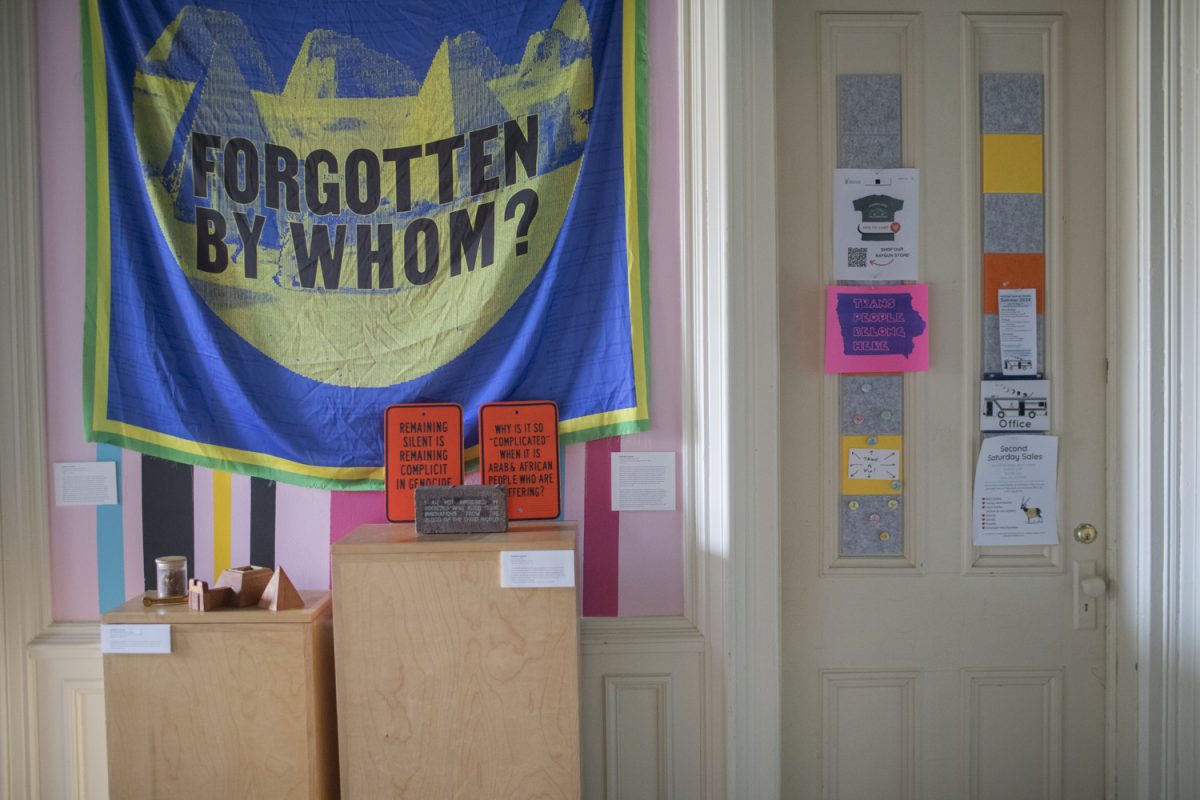Iowa City’s Public Space One and New York-based art collective, Mipsterz, share a common value — platforming innovative art from marginalized voices for no profit. With their recent, jointly-assembled exhibition of multimedia art, Mipsterz sets out to redefine the stereotypes of Muslim art.
“Alhamdu: Muslim Futurism” opened at PS1’s Close House on July 1 and is one of the largest projects the crew has undertaken. Walking into Close House, the exhibition immediately commands attention.
“We wanted to give ‘Alhamdu’ the full space. It was a challenge to make sure we didn’t program anything on top of it,” said PS1 executive director John Engelbrecht.
Nearly the entire space has been reshaped and plays into the exhibit in some way. From the wall decals, lighting, furniture, and, of course, art installations themselves, “Alhamdu” is an experience for all the senses.
Anaïs Duplan, the curator of the Center for Afrofuturist Studies at PS1, met members of Mipsterz in New York five years before the exhibit opened at Close House. The process of accumulating work from members of the Muslim diaspora around the country, and locally in Iowa City, took years — in part because of the necessity to have a clear calendar at PS1 but also because of the exhibit’s touring schedule
“The collection that Mipsterz has put together is a traveling one, which is different from what we usually put on here,” Engelbrecht explained. “There were pieces that we had to cut. We highlighted some more local pieces, so it has this kind of evolving life.”
The show isn’t simply a traveling act, though. The choices for where to bring the gallery tie into Mipsterz’s mission to redefine people’s expectations of what Muslim art is. By servicing areas where Muslim artists are creating work, but not necessarily platforming it, “Alhamdu” gives creators an opportunity.
“These artists exist, they are there. We don’t need to research which cities [have] a lot of BIPOC artists, we know they’re there,” Mipsterz founder Abbas Rattani explained. “We carved out a pretty big chunk of the Iowa City exhibit for local work. There are people everywhere thinking about the ideas [of futurism].”
The specific ideas of Muslim futurism are, like many art subgenres, up to interpretation. Futurism is born out of science fiction and portrays the future, or some unreal world, as a representation of the current culture.
The genre is typically dominated by white artists, though. A major goal of Mipsterz is to open the minds of members of the non-Muslim community, which is a majority of the country, to voices in art they don’t typically see.
“We are in the business of amplifying and incubating Muslim and Muslim-adjacent artists. The definition of Muslim is really up to the artist,” Rattani said. “From our perspective, [Muslim futurism] borrows a lot from Afrofuturist framework.”
The conversation between Muslim futurist and Afrofuturist work is part of what brought Mipsterz and PS1 together — along with both institutions’ belief in making art from marginalized voices accessible.
“This is a community forward space,” Engelbrecht reiterated. “Being in the U.S. where Muslim culture is not the dominant culture, this exhibit is really about resilience and uplifting expectations.”
Using common iconography like UFOs, space, and other futurist staples, “Alhamdu” grants people who might not know what to expect something to ground themselves in. This grounding, in tandem with the variety of mediums, offers something for any art enthusiast to enjoy.
On one wall of the exhibit, a series of hardcover books designed by Safwat Saleem offers a time capsule of being a Muslim parent during a pandemic to the future. Across the hall, an immersive visual and auditory installation brings visitors into the atmosphere of the futurism aesthetic.
The variety of installations further speaks to the goal of grounding people unfamiliar with Muslim art and culture and allowing them to absorb new ideas in familiar ways. The exhibit is open until Aug. 18 at PS1’s Close House and will be capped off with a showcase from Abbas Rattani and members of Mipsterz.
“The way you would suspend judgment and try a food you’re not used to, like trying a burrito for the first time if all you’ve eaten is beef and potatoes, [is similar],” Rattani said. “If you allow your brain to soak in the art, you’ll come away inspired.”



